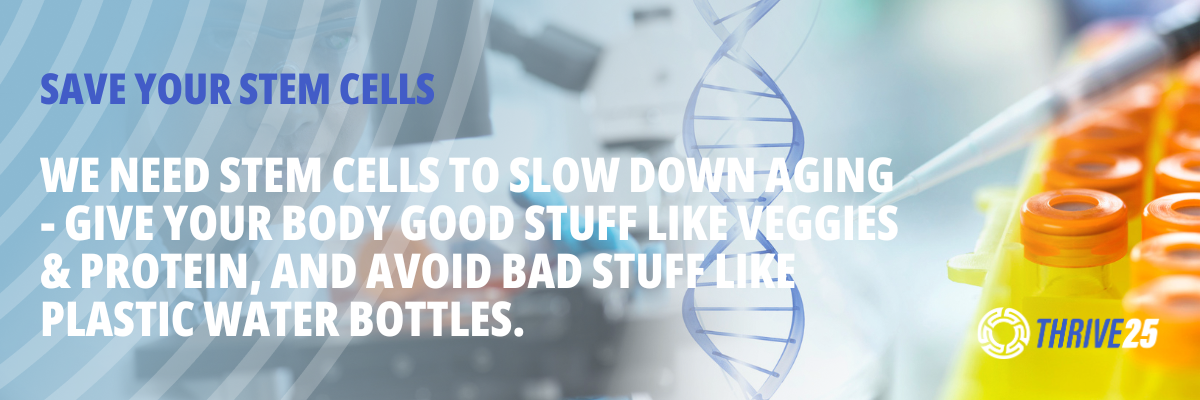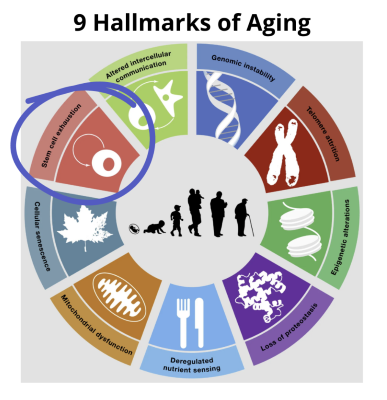Issue #336: Making Sense of Stem Cells
Good morning. It’s Tuesday, April 30th.
Stat of the Day
The amount of energy we make every day - enough to power a dishwasher. (source)
Learn
Making Sense of Stem Cells
Just looking at my 3-yr old’s skin, it’s obvious how healthy he is - there’s barely even any freckles. Just smooth and plump - and if he ever gets a cut it seems to disappear in hours not days.
There’s no doubt we’re the healthiest when we’re born and then life becomes all about protecting our health as we slowly begin to age.
Every day we put our bodies through massive stress and it’s amazing how resilient we are to keep our health as long as we do.
But this ongoing wear and tear - whether from eating food that’s not really food, being exposed to radiation or toxins, or putting our cells through an overload of stress - eventually wears us down.
It doesn’t happen all at once - but the signs are there that we just aren’t quite as young as we used to be - e.g., a recurring back injury, slower mile pace, etc. These are the physical indicators of aging and they are the result of what are known as the “9 Hallmarks of Aging” - the things we can’t see, but are happening inside our body.
One of those hallmarks of aging is losing our stem cells.
When we’re first conceived - we’re nothing more than 150 cells. These are stem cells and they all contain the same genetic code (our genetic code), but they can morph into any and every type of cell we will need to become a human - skin cells, brain cells, lung cells, blood cells.
There are actually two (2) types of stem cells:
Pluripotent stem cells - the kind I just mentioned that become any cell in the body. These either exist at birth OR are created in a lab from tissue-specific cells.
As we get older we still have stem cells - in our bone marrow and fat - but these are less potent than what we had as embryos and infants. Just like the rest of us - they aren’t quite as fit over time.
Plus, these stem cells are most effective in becoming muscle cells, red or white blood cells, and skin cells. We aren’t regenerating our heart and brain everyday.
It’s one reason why there’s a growing movement to save the blood from the umbilical cord and placenta for our kids with companies like Life Bank USA.
We don’t yet know all the ways in which these cells can help us. But the potential might be huge, so it might be worth the $2-5K investment in case.
The other type are tissue-specific stem cells. These cannot change from a blood stem cell to say a skin cell. Instead, they’re responsible for replenishing our cells in that specific organ.
But as we get older, we lose our stem cell reserves and can’t as effectively or efficiently fix problems that affect any of our cells.
The good news?
There are things we can do to prevent - or at least delay - our stem cell deterioration.
The number one thing in our power is taking care of our mitochondria.
Regular Thrive25 readers might be sick of hearing about them by now because they impact just about everything when it comes to our longevity.
These are the little powerhouses - we have 1,000-2,500 in most of our 39 trillion cells - that give us energy from food and oxygen. They regulate our metabolism and are key to our metabolic health.
That’s because we can’t store energy (ATP) - so our mitochondria need to produce it every second of every day. At any given time our cells hold 4.25 watts - the same energy as a AA battery.
So take care of your mitochondria to maintain healthy stem cells and increase your longevity.
Try
3 Ways to Protect Mitochondria
1. Follow the 10-6-1 Food Plan (Issue #235): Eat a ton of colorful fruits & veggies with B Vitamins and antioxidants (10 servings), lots of protein (6 servings), and stay hydrated (1 cup of water every hour you’re awake) - all while skipping the processed foods that make your mitochondria work overtime.
2. Avoid Toxins: those scratches on the CD are from toxins getting into your mitochondria. So avoid plastic water bottles (see Issue #272), nonstick cookware (go with Caraway instead!), and chemical-laced cleaning products or pesticides in your yard.
3. Add Muscle: we just talked about this. Muscle is huge for our metabolic function and stronger bones - all good things for mitochondria and stem cells. (Check out our week on Strength - Issues #330-332)
Thrive25 Partner Spotlight
Exploring a healthier lifestyle or a refreshing twist to your routine?
Discover Hiyo, a non-alcoholic beverage infused with organic adaptogens, natural nootropics, and functional botanicals designed to boost your mood and enhance overall happiness. Whether you're seeking an alternative to traditional drinks or just something deliciously different, give it a try and elevate your beverage experience!
Take advantage of the 15% discount exclusive to Thrive25 readers - use code THRIVE at checkout - CLICK HERE!
Measure
Creatine Kinase
This is the first of two key biomarkers related to creatine. We’ll cover creatine kinase today and creatinine next week.
Creatine is a powerful chemical formed from three amino acids that helps us build muscle, support brain health and encourage DNA methylation (see more in Issue #152).
Creatine kinase (CK) is an enzyme that catalyzes the biochemical reaction to transform creatine into the high-energy molecule phosphocreatine - this is used for energy by our cells. Super important.
What’s my value
CK, also known as phosphocreatine kinase (CPK), enters the bloodstream when muscles are damaged. And the CK blood test measures this value - it can be a great indicator of muscle injury, disease or inflammation.
So what’s normal?
Creatine kinase is measured in units (of enzyme) per liter (of blood serum):
Men: 52 - 336 U/L
Women: 38 - 176 U/L
And optimal?
Well - you’ll notice we have a problem. Targeted stress is a good thing - and when we have intense workouts, our muscles break down, recover and come back even stronger. But when our muscles break down, more CK will make it to the bloodstream. So any measurement of CK levels is highly dependent on the intensity of your workouts.
So while the optimal range is the lower half of normal, if your workout intensity is high, you’re more likely to be in the upper half. The key here is the upper bound. If you’re higher than 336 for men and 176 for women, then your doctor will recommend diagnostic testing to determine the issue.
How do I gauge workout intensity?
It’s all about your heart. While intensity is subjective, there are objective ways to measure. If you’re getting 150+ minutes of Zone 2 exercise per week with 30-60 min Zone 5, then you’re likely in the medium-high range. If you’re a professional athlete, Olympian or just finished a triathlon or marathon, then let’s go with pretty intense. Everyone else should be in the lower half of the CK range.
In the News
Going Green: From stainless steel water bottles and cloth grocery bags to silicone food storage bags and bamboo utensils, these eco-friendly alternatives not only help protect the environment but also save you money in the long run. (WIRED)
7 Yoga Books to…: …get started…stick with it…optimize your practice…become a Yogi. Fourteen teachers share their recommendations for students of all levels. (NYTimes)
Personalized Cancer Vaccines: Cancer cells are covered in mutated proteins called neoantigens that don’t exist on healthy cells. These neoantigens could be targeted by the immune system with a little help from personalized vaccines. (Big Think)
Thanks for joining us today!
Check out the latest videos on our YouTube channel
Got feedback, recommendations or stories to share? Tell us what’s on your mind here
Want this direct to your inbox? Sign up here
Why Thrive25
We’re 40-something dads that felt our bodies and minds start to slow down and we’re not ready for that. We found too much information on every subject. So we started Thrive25 to transform what we’ve learned into something useful for the rest of us to spend just 3-5 min a day to optimize our health & longevity.
This newsletter is for you and we truly value your feedback. Never hesitate to reach out to us at team@thrive25.com.
To health!
Sign up for free:
The information in this newsletter is for informational purposes only and may not be appropriate or applicable based on your individual circumstances. Thrive25, Inc. does not provide medical, professional, or licensed advice. Please connect with your healthcare professional for medical advice specific to your health needs.







